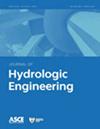利用校正后的数值天气预报产品短期预报蒸发皿每日蒸发量
IF 1.9
4区 工程技术
Q2 ENGINEERING, CIVIL
引用次数: 0
摘要
数值天气预报可为今后16天蒸发皿蒸发量预报提供重要信息,对水资源管理有重要帮助。然而,预测Ep的信息通常需要偏差校正。本研究基于三种偏差校正方法[等距累积分布函数法(EDCDFm);利用中国南方18个气象站的气象资料,对第二代全球综合预报系统(GEFSv2)预报的气象因子进行了偏置校正,并对单气象因子输入(M2)的XGBoost (XGB)和多气象因子输入(M3)的XGB进行了偏置校正。结果表明,M3方法对GEFSv2输出的偏置校正能力优于M1和M2方法。这是GEFSv2输出与相应观测数据之间的模型数据误差。太阳辐射误差最小,最低温度误差最大。M3方法降低了预测模型数据误差。此外,本研究还比较了M5Tree (M5T)、random forest (RF)和XGB三种基于树的模型对Ep的预测能力。XGB模型对Ep的预测精度最高。采用M1、M2和M3方法校正的NWP输出作为XGB模型的输入,1 ~ 16 d期间18个站点的平均绝对误差(MAEs)平均值分别为0.99 ~ 1.69、0.78 ~ 1.14和0.78 ~ 1.07 mm/d。夏季EP预报误差最大。相对湿度对Ep预报误差的贡献最大。通过解决NWP输出应用于Ep预测的问题,本研究提高了对NWP输出的偏差校正方法和基于树的模型预测Ep的理解。它还提高了对Ep预测的季节性表现和气象因素对预测误差的影响的认识,可以为未来的研究和模式提供信息。本文章由计算机程序翻译,如有差异,请以英文原文为准。
Short-Term Forecasting of Daily Pan Evaporation Using Corrected Numerical Weather Forecasts Products
Numerical weather prediction (NWP) can provide vital information for pan evaporation (Ep) forecasts for the 16 days ahead, which is of great help to water resources management. However, the information for forecasting Ep usually requires bias corrections. This study was based on three bias correction methods [the equidistant cumulative distribution function method (EDCDFm; M1), XGBoost (XGB) with a single meteorological factor input (M2), and XGB with multiple meteorological factor input (M3)] and the meteorological data from 18 weather stations in southern China, the bias correction of meteorological factors forecasted by the second-generation Global Ensemble Forecast System (GEFSv2) was carried out. The results indicated the bias correction ability of the M3 method for GEFSv2 outputs was better than that of the M1 and M2 methods. It was a model-data error between GEFSv2 outputs and the corresponding observation data. Solar radiation exhibited the lowest error, whereas minimum temperature exhibited the highest. However, the M3 method decreased the forecast model-data error. In addition, this study compared the ability of three tree-based models to forecast Ep, namely, M5Tree (M5T), random forest (RF), and XGB. The XGB model had the highest forecasting accuracy for Ep. When the NWP outputs corrected by M1, M2, and M3 methods were used as the input of the XGB model, the averages of mean absolute errors (MAEs) at the 18 stations during the 1–16 day period ranged at 0.99–1.69, 0.78–1.14, and 0.78–1.07 mm/day, respectively. EP forecast showed the most significant error in the summer. Further, the relative humidity contributed the most to the Ep forecasting error. By addressing the issue of NWP outputs applied to Ep forecast, this study improves understanding of the bias correction method of NWP outputs and tree-based models to forecast Ep. It also improves understanding of the seasonal performance of Ep forecast and the impact of meteorological factors on forecast error that can inform future studies and models.
求助全文
通过发布文献求助,成功后即可免费获取论文全文。
去求助
来源期刊

Journal of Hydrologic Engineering
工程技术-工程:土木
CiteScore
4.60
自引率
4.20%
发文量
83
审稿时长
4.5 months
期刊介绍:
The Journal of Hydrologic Engineering disseminates information on the development of new hydrologic methods, theories, and applications to current engineering problems. The journal publishes papers on analytical, numerical, and experimental methods for the investigation and modeling of hydrological processes.
 求助内容:
求助内容: 应助结果提醒方式:
应助结果提醒方式:


